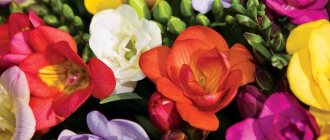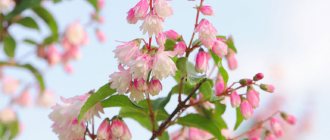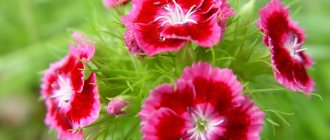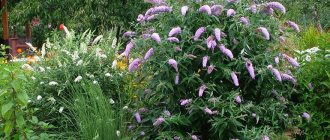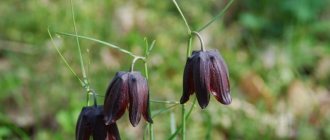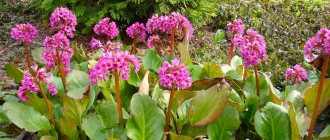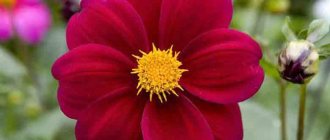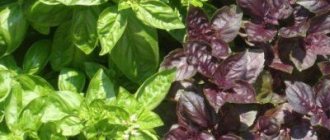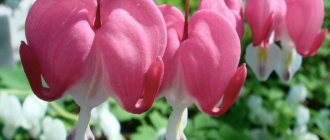Freesia is a delicate, poisonous plant native to South Africa. The leaves are sword-shaped or wedge-shaped, often light green in color and can reach a length of 30-40 cm. Freesia flower stems are slender, straight, always of approximately the same height. Eight funnel-shaped flowers form a loose cluster at the top of each stem. At the point where the flowers begin, the stem bends sharply, so that the buds always point upward.
Belongs to the division of magnolias (Magnoliophyta), family Iridaceae, the genus Freesia contains, according to various sources, 14-20 species that are of African origin. Freesia flowers are very fragrant and are usually white or yellow. The plant grows from a solid bulb, the same as that of gladiolus. The first to appear above the ground is a bunch of long narrow leaves and a slightly branched stem.
The flower was named in honor of the German doctor and botanist Fries (1785-1876). Selected varieties amaze the imagination with their multi-colored buds; they are golden yellow, orange, red, pink, lilac, lavender, purple and often even two-colored in various combinations.
Perennial plants ideal for both indoor and outdoor use. They are very much in demand in floristry, require minimal care, are practically not susceptible to diseases and pests, and are capable of self-propagation in open ground.
Description and characteristics of the flower
Freesia is a corm-shaped flowering plant from the Iris family. The birthplace of the flower is considered to be South Africa - the Cape Province. Here it grows on the banks of rivers, hiding in the shade of spreading trees and bushes. This habitat affected the character of the plant.
Freesia prefers high humidity, warmth and partial shade.
There are 20 varieties of freesia known in the world, but only 3 are grown by flower growers:
- hybrid freesia;
- Armstrong;
- broken.
Some varieties of flowers can reach a height of up to 1 m. When growing them, special supports are installed. Freesia flowers can be multi-colored or monochromatic. The color range ranges from bright shades to pastels. There are white, blue, purple, yellow, red buds as in the photo.
The core is contrasting with the petals. There are up to 6 buds in one inflorescence, which are shaped like bells with 6 petals. When freesia blooms, a special aroma spreads throughout the area, which is compared to lily of the valley.
The leaves of the plant are narrow, up to 15 cm long and up to 2 cm wide. The stems are thin and bare, branched. The height of an adult plant can reach more than 70 cm.
The main feature is the renewal of the bulbs. This happens every second growing season. During the renewal process, the tuber dies and a new one is formed. Freesia has a dormant period that occurs after flowering.
The flowers of the plant are used for bouquets - they can last for more than 10 days without fading and retaining their aroma.
Freesia was used to create compositions for decorating Versailles.
Description: What does the plant look like?
Freesia (lat. Freesia Exklon ex Klatt) is a beautiful plant of the Iris family.
At home, hybrid forms of this herbaceous perennial are most often grown.
Botanical description:
- conical bulbs, up to 2.5 cm;
- leaf blades are green, xiphoid, basal, erect, up to 30 cm in length;
- peduncles are tall, vertical, each bears several flowers, which open from bottom to top in turn;
- shades of petals include the entire color gamut, with the exception of black.
Types and varieties of freesia
Photos of freesia confirm the beauty of flowers and the variety of colors. Many plant varieties have been developed through selective breeding. Hybrid or broken freesia and Armstrong freesia were used as a base. Freesia is added to perfumes and gives compositions a note of freshness.
Armstrong's Freesia Freesia Armstrongii
The height of the stems reaches 70 cm. The buds are yellow-red. Inflorescences contain 3 or more buds. The shape of the flowers resembles bells. The saber-shaped leaves are narrow and long. The flowering period for Armstrong freesia is from May to the end of June.
In gardening, the Cardinal variety is found. The buds are non-double, red in color. One plant can simultaneously produce up to 3 flower stalks 0.35 m high. The number of buds in one inflorescence can reach 11 pieces. Dark red flowers have a base with a yellow spot, a blue pistil, and purple dust particles.
Freesia hybrid Freesia hybrida
Most often grown by gardeners. The variety is ideal for indoor growing. It can reach 1 m in height. The stem is branched. The inflorescences consist of large buds, the diameter of which can reach 7 cm. The petals can be from purple to yellow. Petals are one-color or two-color.
The most common varieties of freesia:
- Pimperina. The height of the peduncles is 15-20 cm. The inflorescences contain 6 small buds. The color of the petals is red with a dark red and corrugated edge. There are yellow streaks on the bottom of the petals. It has a weak aroma.
- Rose Marie. The height of the peduncles is 25 cm. There are 7 buds in each inflorescence. The petals are distinguished by a rich crimson color and a white throat with crimson strokes.
- Ballerina. It is distinguished by white corrugated petals and a light yellow base. The throat is white with yellow stripes. Inflorescences consist of 10-12 buds. Peduncles can reach a height of 30 cm. White freesia is distinguished by a pleasant and delicate aroma.
- Pictures. Distinguished by creamy petals. Used by florists when making wedding decorations. White Freesia Pictures has snow-white petals. Photos of this variety are used in magazines.
Recently, the Rose Marie variety is rarely found on sale. But every year new varieties with double and simple flowers are developed.
Broken freesia Freesia refracta
This variety gets its name because of the inflorescences, which bend back when formed. The height of the flower is up to 40 cm. Freesia is distinguished by its broken branched stem, spike-shaped and paniculate inflorescences, which consist of 2-5 buds. The flowers of this variety can be yellow-orange or snow-white.
This variety includes the following varieties of freesia:
- Alba. The variety is distinguished by large inflorescences. Snow-white petals of buds with a golden throat are often decorated with purple stripes.
- Fragrant. Inflorescences include up to 7 buds. The flowers are yellow with orange spots at the base. The variety got its name due to the aroma it exudes, similar to the aroma of lily of the valley.
The variety also has other names: white or broken freesia. The buds of this variety bloom in April.
Caring for freesias after flowering
In the fall, after flowering is completed, the tubers are dug up and stored until next year.
In the house
Above-ground shoots are cut off, the roots are watered for 1-1.5 months to form children. Next, they are extracted, treated with manganese, and dried at +25...28 °C. Then they sort, selecting damaged and rotten ones.
In the open ground
When the platinum leaves turn yellow in October, the corms are dug up, the stems are cut, cleaned, and sorted. Disinfection is carried out (treated in Fitosporin, Azobacterin), dried and stored.
In warm climates, planting material is left for the winter, covered with a layer of mulch.
Bulb storage
Store planting material in a dark place, in nets, at high humidity and temperature +29...+31 °C, for 12-16 weeks, then reduce (two weeks before planting) to +12...+13 °C.
Freesia planting and care in open ground
To grow freesia in open ground, carefully choose a place, taking into account the characteristics of the plant. Planted in a flower garden in the spring, when night frosts pass (early May). Bulbs or seeds are used as planting material. Low-growing ones require dense planting, while spreading ones do not like crowding; plants with weak stems need support.
Freesia is sensitive to soil composition, climate, and temperature. She is light-loving, does not like drafts and stagnant moisture.
Planting by seeds
Planting freesia seeds is a labor-intensive process. Using such planting material, it is not always possible to grow flowers, since planting freesia is not enough, it is necessary to provide proper care. Seeds are selected zoned. Planting material is treated with a solution of potassium permanganate for disinfection.
Sowed in early March. The plantings are deepened to 8-10 cm. A layer of neutral peat is laid on top of the soil and watered. To improve germination, organic fertilizers are used.
Planting freesias with seeds is relevant for southern regions with a humid and warm climate.
Planting with bulbs
Planting freesia bulbs requires preparation. Planting material must be grown. In March, the bulbs are cleared of scales and dipped in a 0.2% Fundazol solution for half an hour. This protects plants from fungal diseases. The prepared bulbs are planted in peat pots filled with loose and nutritious soil. The plantings are deepened to 5 cm. The pots are placed in a warm loggia or on a windowsill with good lighting.
After warm weather sets in, the bulbs are planted in open ground. The air temperature must be at least 15 °C, and the soil temperature - 12 °C. If there is a threat of night frosts, flower beds with freesia are covered with film. The distance between plants is up to 5 cm, and between rows - 15 cm. The bulbs are planted together with a peat pot.
For the winter, the bulbs must be dug up.
The soil
Before planting freesias in open ground, you need to choose the right place and prepare the soil. The plant does not like drafts, stagnant moisture and direct sunlight. The ideal place is under bushes and trees. The flower bed should be raised so that the water does not stagnate.
The soil for freesias should contain leaf and turf soil, humus with a small amount of sand. When digging a flower bed, charcoal is added. In terms of acidity, the soil should be slightly acidic - pH 6-6.5. These plants do well in simple garden soil. The soil must be loose.
If a crust forms on the flowerbed, then loosen the soil. Do this carefully so as not to damage the bulbs. Weeds must be removed. This protects the bulbs from rotting and provides air flow.
Faded buds must be removed. Otherwise, the plant devotes all its energy to forming seeds, depleting the bulbs.
Lighting
Freesias are light-loving plants. But direct sunlight is dangerous for them. Flower beds with such plants are placed in shaded but well-lit places. Freesias require 12-14 hours of daylight.
Watering and moistening
Growing freesia requires compliance with watering rules. Flower beds with plants are regularly moistened. During the period of vegetative growth, freesia is watered daily, but not abundantly.
Excess moisture causes the bulbs to rot.
In the evening, the plants are sprayed.
Fertilizer and feeding
Caring for freesia requires regular feeding. After the first leaves appear, the plants are fed with ammonium nitrate. A solution is prepared from it: 20 g of the drug is diluted in 10 liters of water. After 10-15 days of planting, they are fed with another solution: 20 g of potassium salt and 40 g of superphosphate are diluted in 10 liters of water.
Only liquid formulations are used to feed plants. Dry fertilizers are not suitable for freesias. After the end of the flowering period, the plants continue to be fed once every 14 days, because the bulbs in the soil continue to grow. At the same time, organic and mineral fertilizers are alternated.
Diseases and pests
The danger for freesia comes from aphids, spider mites, and thrips.
If the plant is attacked by aphids, the leaves and shoots begin to wither and the plant weakens. Pests feed on freesia sap. In the process of their life activity, they leave a sticky coating that blocks the access of air to the plant tissues. This leads to the development of fungal diseases.
Spider mites also weaken plants. Freesia looks sick. If you turn the sheet over, there will be sticky cobwebs on the back side. Spider mites are small - from 1 mm. It feeds on plant sap and leaves small spots on the leaves that gradually lose color. The leaf turns gray, then yellow. If the plant becomes infected during the formation of buds, there will be no flowering - the buds will fall off.
Thrips also feed on plant sap. As a result of their activity, voids are formed in the tissues of freesia. The plant becomes covered with gray spots, photosynthesis stops, which leads to the death of the freesia.
To combat aphids, thrips and spider mites, insecticides are used, treating plants once a week.
It is necessary to carry out procedures until the pests are completely gone.
Due to improper care, freesia can develop various rots, scabs, and fusarium. To eliminate the disease, plants are treated with fungicides and the maintenance conditions are changed. If the disease is viral, the leaves and flowers die. Diseased plants are destroyed to prevent the spread of disease.
Diseases and pests
Freesias on the site will decorate any garden. As a rule, plants are not particularly susceptible to diseases and do not have direct natural enemies from insects. However, here are a few major problems you may encounter when growing flowers.
Aphid
These small, numerous insects can periodically attack freesia, primarily causing leaves and buds to curl. If no countermeasures are taken, the leaves will begin to turn yellow and the buds will fall off. Getting rid of aphids is quite simple - just irrigate the plant several times a week with a light soapy solution or install ant bait near the flowerbeds.
Slugs and snails
These parasites cause the most damage to plant foliage, which they actively eat, attaching themselves to the reverse side. Elimination of the invasion will have to be done by manual collection of pests; it is best to do this at night, when their activity is highest. For prevention, spray a soap solution over the entire area. Additionally, you can use diatomaceous earth by scattering it under the stem of each plant.
Bacterial infection
There are quite a few types of bacteria that can infect a plant and cause it to rot. The most common condition for freesia is the appearance of soft rot in the form of small watery brown spots on the leaves, stem and flowers, which later darken and become gray in color. The cause of infection is excess moisture. The affected parts of the plant are cut off, and watering is temporarily reduced until complete recovery. To prevent the spread of bacteria, it is better to completely destroy the most affected plants.
Fungal diseases
The fungal pathogen Fusarium wilt most often attacks a plant when there is excess moisture around the roots and increased mineral content in the soil. The flowers will slowly begin to fade, even if you reduce watering. There is no truly effective treatment. Destroy infected plants and solarize the soil in the area.
Iris spot
This is a viral disease that most often affects irises, hence its name. It appears as small light brown spots about 0.5 cm in diameter, which over time grow over the entire area. Photo of the affected freesia below. You can save the bulbs by cutting off the shoots completely and then replanting them in a new location.
Temperature damage
A sharp increase in temperature by more than 15 degrees will lead to a rapid cessation of flowering. The buds will fall off in literally 1-2 days, after which the stems will begin to lengthen excessively. When the temperature drops to +5-0 degrees, the leaves will become translucent or gray, after which the entire plant will wilt.
Freesia propagation
To propagate freesia, seeds and daughter bulbs are used. The last method is the fastest. When using daughter bulbs, the chances of growing a healthy and strong plant are much higher. Seed propagation is suitable for experienced gardeners, as this process is complex.
Propagation by seeds
Sowing of seeds begins in March. The container is filled 1/3 with expanded clay, and then with soil consisting of equal parts of sand, humus and peat. You can purchase a ready-made substrate for bulbous plants. The soil is moistened and seeds are laid on its surface. A layer of soil up to 2 cm thick is poured on top of the planting material.
The container is covered with film or glass and transferred to a lighted windowsill or loggia. The covering is removed several times a day to remove condensation and ventilation.
For seed germination, the temperature is maintained within 20-25 °C.
After the sprouts appear, the plantings are regularly watered, sprayed with a spray bottle, and ventilated more often. The first shoots appear after 10 days. Remove the film or glass from the pot after 30 days. The seedlings are planted using the picking method. The distance between seedlings is made at least 5 cm.
The container with seedlings is placed on the balcony, but protected from drafts. Plantings are carried out here all summer. When the air temperature drops to 10 °C, the container with freesia is moved indoors, watered regularly, and fed 2 times a month.
The first flowers may appear in February. At the end of the flowering period, the flower stalks are cut off, and the bulbs are left to ripen in the pot, reducing watering. By mid-summer, freesia is no longer watered, and in August the bulbs are dug up for storage. For winter forcing, the bulbs are planted again in October.
Attention! The flower is sensitive to excess fertilizer.
Propagation by bulbs
During the flowering period, children begin to form around the mother tuber.
When the plant has flowered, the flower stalks are removed.
All the plant’s forces are directed to growing bulbs. After the ground part has completely withered, the freesia is left in the soil for another week. Then the plant is dug up and the bulbs are dried.
The children are separated from the main tuber. The first year they do not produce flower stalks, they increase their mass. The babies are planted like the mother tuber, but in a separate flower garden. They are left in the ground until the above-ground part begins to wither, then they are dug up, processed, dried, and placed in nets.
"South African lily of the valley"
This beautiful plant with a pleasant lily of the valley aroma comes from South Africa, for which it received the common name “Cape lily of the valley.” The main name is associated with the name of the German botanist Frieze, who discovered a charming flower to the world, which impresses with the variety of colorful colors of the petals.
In the wild, freesia grows in the shade of bushes near water bodies. Gardeners and flower growers grow it both in the garden and on window sills in pots. But this South African plant has won the greatest sympathy among florists, winning their hearts with its charming branches with fragile delicate flowers that look so harmonious in almost any bouquet. The smell of the flower is so attractive that it is widely used in the creation of luxury perfumes, and freesia oil is often used in aromatherapy.
Tuber storage
After the ground part of the freesia plant has withered, around September-October, the bulbs are dug up. The stem is completely cut off, the soil is cleared, and dry scales and roots are removed. Be sure to soak in a solution of fungicide or potassium permanganate for 30 minutes. You can use “Fundazol”, “Fitosporin”. The planting material is dried for 2 days at a temperature of 25-28 °C. Tubers are sorted before storage, discarding rotten and damaged ones.
Nets are used for storage. Storage conditions: humidity up to 80%, temperature from 20 to 25 °C. To increase humidity, place a container of water. Once a month, planting material is inspected, discarding those that have begun to rot.
A month before planting, the tubers are placed in a cool place where the temperature varies from 10 to 15 °C.
If the region has a mild climate and not a frosty winter, the bulbs are not dug up. The plantings are covered with dry leaves or spruce branches.
Useful video
The video shows how to plant bulbs in the ground:
When growing freesia at home, you need to remember the main conditions for its successful cultivation. They consist in strict adherence to all the rules, otherwise the capricious plant will not release flower stalks or will not come out of the dormant phase at all.
Read about other bulbous houseplants: spiral albuca, amaryllis, wallota, hemanthus, hyacinth, hippeastrum, gloriosa, drimiopsis, zephyranthes, Indian onion, calla, clivia, crinum, narcissus, nerine, oxalis, lily, scylla, eucharis. The catalog of all types is here.
Growing freesia at home
Since it is not possible to grow freesia without shelter in all regions, the plant is bred indoors. By creating ideal conditions, you get a plant that blooms until January. It is easier to maintain temperature conditions, control watering and lighting when growing indoors.
Landing
Some freesia varieties are planted 6 months before flowering. Planting algorithm at home:
- The bulbs are soaked in a solution of Azobacterin. To do this, 0.5 g of the drug is dissolved in 10 liters of water. The bulbs are placed in the solution for 30 minutes.
- Choose a small flowerpot - up to 15 cm in diameter. The container is filled 1/3 with drainage. Stones and expanded clay will do.
- The rest of the pot space is filled with soil. To do this, mix humus, turf soil and sand in equal proportions. Be sure to add charcoal. The soil in the pot is not compacted.
- Plant 5 bulbs in one pot, deepening the plantings by 5 cm.
- The containers are transferred to a room where the temperature does not exceed 15 ° C. Do not water.
- After germination, the pots are transferred to a permanent place where all conditions for freesia are created.
Depending on the plant variety, support is installed in the pots. Subsequently, the freesia is watered, fed, and sprayed.
Care
When grown indoors, freesia is watered daily, but no later than 5 p.m. By the end of the day the soil should dry out.
With the onset of the dormant period, watering is reduced to a minimum and then stopped.
Plants cannot tolerate stagnant air. Pots with freesia are placed on a shaded window, leaving a distance between the containers. The plant loves light, but it must be protected from sunlight. Freesia requires 12-14 hours of daylight. In winter, special lighting is used with a filter made of white paper or fabric. When airing, pots with freesia are taken to another room, because drafts are dangerous for her.
Caring for freesia continues even after the stems have withered. The above-ground part of the plant is cut off. The bulbs are left in the soil and watering continues in the same mode. During this period, the plant forms children. After 2 months, the bulbs are dug up, disinfected and prepared for wintering.
Care
Freesia flowers are quite easy to grow and care for. In the fall, you can worry about obtaining bulbs for spring planting, while the mother plant itself will remain in place.
Location on the site
In open areas, the plant must be planted at a certain distance of 20-30 cm, since over time the underground root bulbs will independently sow the gaps.
The soil
Freesia loves nutritious, mineral-rich, well-drained soil . Watering is carried out regularly, excess moisture will go away on its own, but under no circumstances should the soil dry out, especially in the summer.
Watering
Watering must be carried out constantly, but moderately. Too much water will cause root rot. To conserve water, cover the soil around the flowers with a thin layer of mulch. In addition to retaining moisture, mulch will help to “clog” unwanted weeds.
Fertilizers
Organic fertilizers in the form of fresh manure are applied to the soil in the spring. Dry manure can be spread over the site closer to autumn, when the plant has completely faded and begins to prepare for wintering. During the active growing season, in the first and second years after planting, potassium-rich fertilizers are added to the soil.
Trimming
Many freesia varieties grow and die completely twice a season. Withered flowers and leaves are cut only in the fall to the very root level with the ground level; in the summer they should not be touched. Pruning of stems can only be done if their height exceeds 50-60 cm, and then not all at once.
To grow straight and even stems of flowers (for sale), it is necessary to install a special support near each plant, to which the stems are attached.
Preparing for winter
After final flowering, cut off any faded buds and continue to water the plant for a while until the foliage begins to turn yellow. When the shoots completely wither, cut off all the tops and cover the ground with a layer of crushed leaves, pine needles, straw or ground bark. If frosts in your region are more than -10 degrees, you will have to dig up the root bulbs and move them indoors, where they are stored at a temperature of +10-12 degrees until next spring. See photos below of preparing freesia for winter.
Optimal soil composition
You can get healthy flowering bunches if you take into account important tips for choosing soil. When planting tubers outdoors, you should choose soil that has neutral acidity; an option with a slightly acidic environment is also suitable.
If the soil’s parameters do not meet the requirements, it can be diluted with sand or peat.
Remember to fertilize poor soil. Organic substances and mineral granules should be added to it.
Time for planting in soil
Cape lily of the valley is absolutely not frost-resistant. You can plant bulbs only after warmth has firmly reigned outside, and the return of cold weather is not predicted. Light frosts can destroy sprouts that have already sprouted.
Tubers are planted in May - early June, if we are talking about central Russia. In other climatic zones, you should focus on the unique features of weather conditions.
If we are talking about the northern regions of the country, then plants already grown in the apartment should be planted in the ground.
Requirements for soil, temperature
Regardless of which variety and which method of growing alstroemeria we choose, we need to provide it with the right conditions so that it can bloom profusely all summer.
To grow alstroemeria, you need to choose a warm, very bright position, protected from direct sun. You also need to choose a place protected from the winds. The plant does not like low temperatures or too high.
Ideally a bright place with diffused light. The plant does not like southern balconies and window sills. It also does not like shadows; due to a small amount of light, flowering becomes less abundant. In hot summers, a little coolness is needed, which promotes long-term flowering, so eastern or western exposure is preferable.
A place where the sun illuminates the plant in the morning until 10-11 am and in the evening after 6 pm is ideal.
Alstroemeria needs soil with the following characteristics:
- fertile;
- humus;
- permeable;
- constantly slightly damp;
- with a slightly acidic pH (5.5-6.5).
